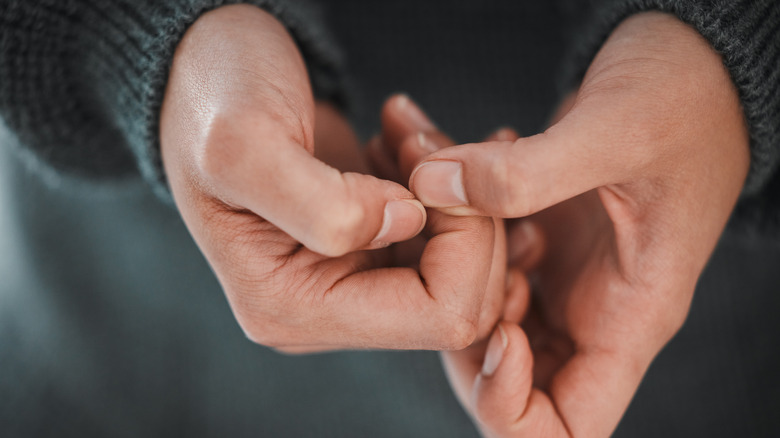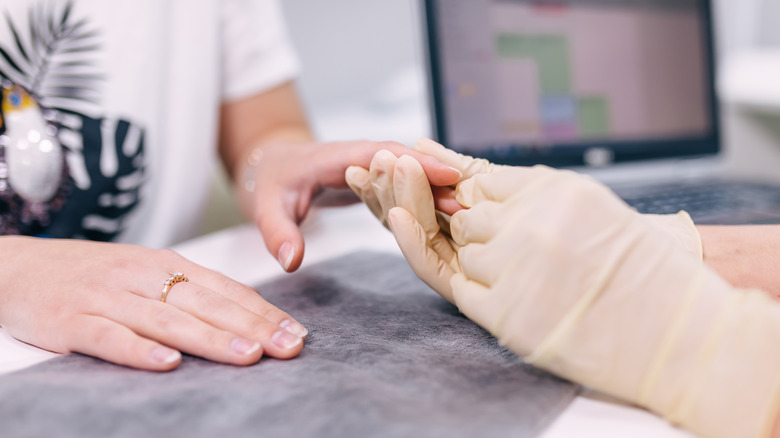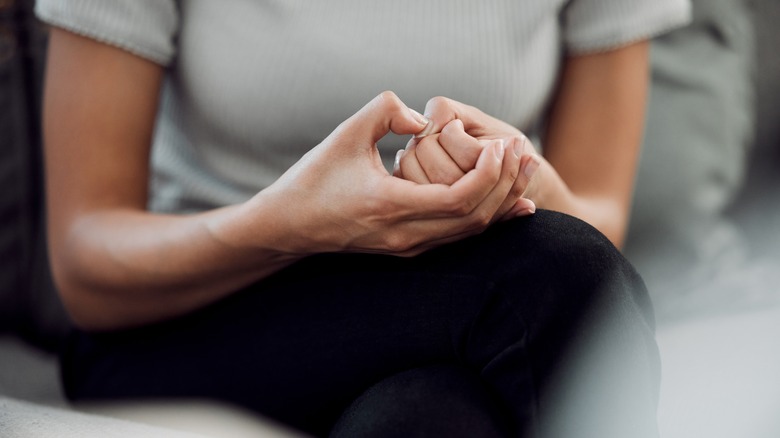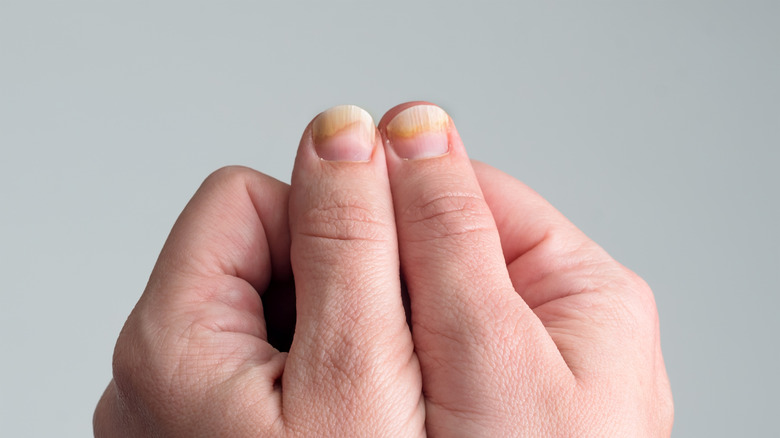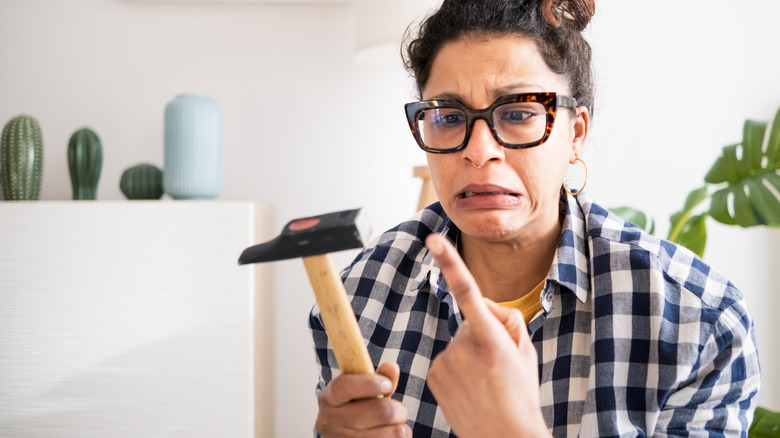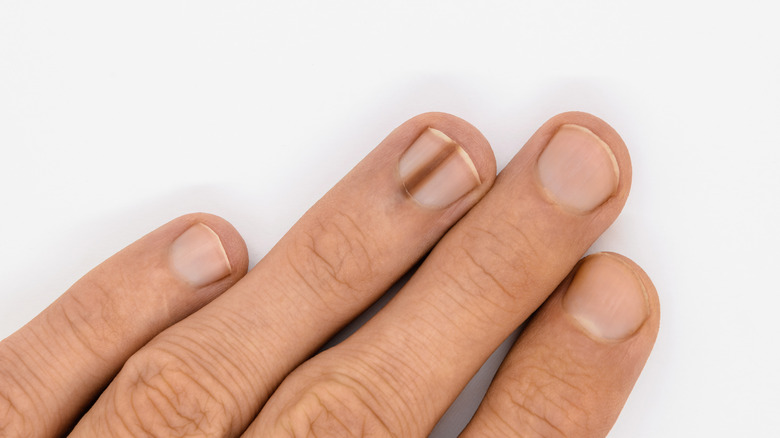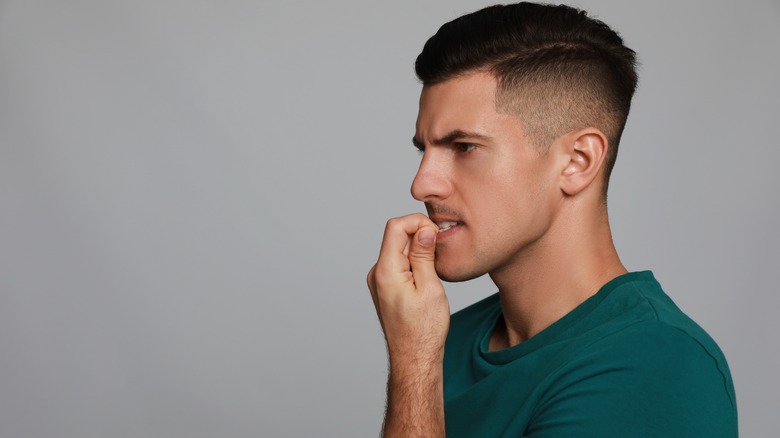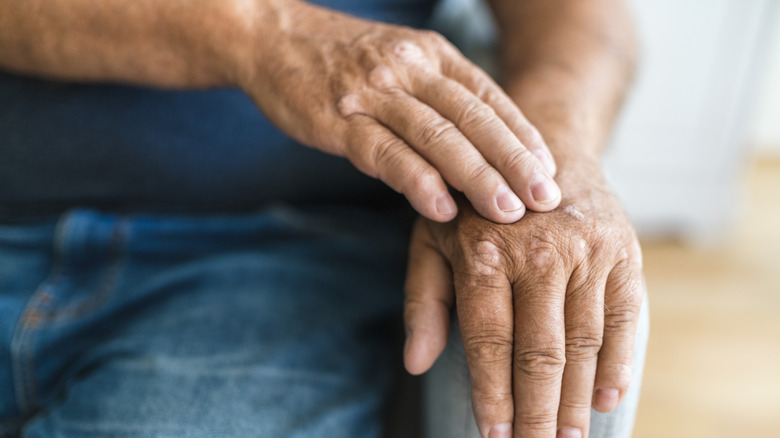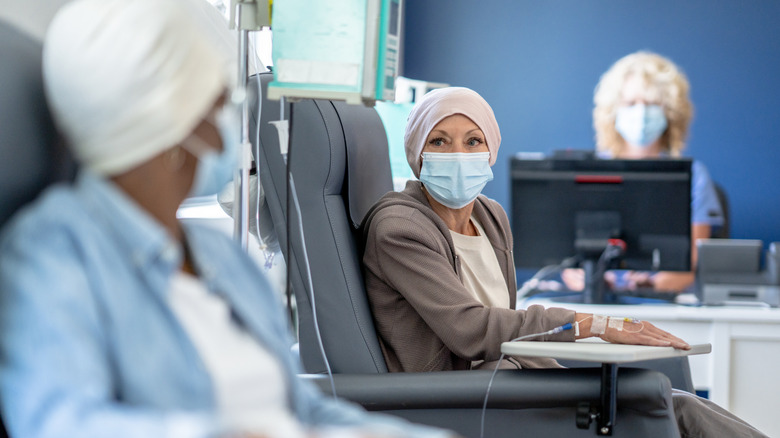What It Really Means When Your Fingernail Hurts When Pressed
Have you ever wondered if there's anything more to your fingernails than serving as an aesthetic accessory to your hands? After all, people do not really need fingernails or toenails to live. According to Patient, evolution is believed to be the culprit behind them. Long ago, our mammalian ancestors had claws to help them with their daily activities, such as climbing trees and digging holes. As they evolved into larger animals, their claws became more of a hindrance, so they slowly transformed into the nails that we now have. Healthline adds that fingernails also offer protection against bacteria and viruses, strengthen our grip, and help us perform fine motor movements.
Fingernails are made of keratin, a type of protein produced by the body. Britannica explains that nails grow from the base, where specialized cells continuously produce new cells and push old cells forward. After some time, the old cells die and turn white as they lose contact with the nail bed. This is the part of the nail that we have to frequently trim off. The nail plate is the reddish part of the nail that is still attached to the nail bed. The nail bed has a rich supply of blood vessels responsible for its reddish hue, and a network of nerves which allow us to feel pain and pressure.
When the nails get damaged, their nerve supply becomes disrupted, which explains why our fingernails hurt when they are pressed. Below are some of the reasons why this happens.
Paronychia
Paronychia refers to infection of the nail. It can happen following breaks in the skin surrounding the nails, physical trauma (e.g., nail biting, frequent manicures), and/or skin irritation from water or chemicals. It may also be caused by certain types of medications like retinoids and antibiotics. Bacteria or fungi can enter the skin near the cuticle and nail fold. This leads to inflammation around the nail, which becomes red, warm, swollen, and tender to touch (via Medical News Today).
According to Cleveland Clinic, paronychia can either be acute or chronic. Acute paronychia develops quickly, does not invade deeper structures of the finger, and typically resolves within weeks. Meanwhile, chronic paronychia develops slowly, takes longer to cure, and may be present in more than one nail. If the infection is mild, you may be able to get rid of it by doing a warm water soak several times a day for 15 minutes. If it does not improve, you will have to see your healthcare provider to get it treated. Without treatment, the affected nail can get permanently damaged. In rare instances, it may spread deeper and infect the bone, and the affected area may need to get amputated. This is especially true for people with inadequate blood circulation such as those with diabetes.
To prevent paronychia, practice proper nail hygiene. Keep your nails short and clean, moisturize your hands when your skin feels dry, and avoid biting your nails, submerging your hands in water for a long time, and exposing your hands to known irritants.
Hangnails
As GoodRx Health explains, hangnails are those pesky pieces of torn skin that pop out near your cuticles and along the sides of your nails. They develop when the skin surrounding your nails are dry, or when you get a minor cut or trauma in that area. Certain habits, exposures, or conditions may also make you more prone to developing hangnails. According to WebMD, these include frequently using nail polish remover, exposure to harsh chemicals or extreme temperatures, submerging your hands in water for long periods of time (e.g., washing clothes, washing dishes), and having a weak immune system (which can cause you to have brittle nails).
If you have ever felt tempted to pull off a hangnail (like most people do), then you probably know that it is not easy to get rid of them without causing a tear on your skin. Not only is this painful, but a break in your skin makes it easy for microbes like bacteria to enter, increasing your risk of developing an infection (i.e., paronychia). So as tempting as it may be, do not try to pull off your hangnails. Instead, remove them safely by gently clipping them off at the base with clean nail clippers. Afterwards, soak your nail in warm water and apply some antibiotic cream if the deeper layers of your skin are exposed. Keep your hands clean as much as you can until it completely heals. If it becomes infected, seek care from your doctor to get proper treatment.
Ingrown nails
Unlike hangnails, ingrown nails are not made of skin. Rather, they are a part of your nail that grows into and pierces your skin instead of growing outside of it like the rest of your nail. According to Drugs.com, this can happen when you trim your nails too short. The area where your nail is growing under the skin can become red, swollen, and painful. If it becomes infected, pus may also form and drain from the nail.
Medical News Today suggests ways you can try to treat ingrown nails at home. Before doing anything, however, make sure you properly wash your hands with soap and water. If you notice a mild ingrown nail beginning to form on one of your fingers, try soaking your finger with warm salt water for 15 to 20 minutes several times a day. If this does not help, try to lift the ingrown nail away from the skin by wedging cotton, gauze, or dental floss under the nail to separate it from the skin. If the ingrown nail is too deep into the skin or if it becomes infected, you will need to see your doctor for proper treatment. If you have diabetes, or problems with your nerves or circulation, avoid treating ingrown nails yourself.
Per Avita Health, you can help prevent ingrown nails by cutting your nails straight across. Moreover, avoid cutting the sides of your nails all the way back to where your skin is, and avoid picking at your nails.
Fungal infection
Like bacteria, fungi can also enter the body through breaks in the skin and infect the nail area. Fungi can directly damage the nails and make them thick, brittle, deformed, foul-smelling, and discolored. It may affect only one nail or several nails. This condition is called onychomycosis.
Per Mayo Clinic, people who are at an increased risk of developing a fungal nail infection are those who are older, wear shoes that cause their feet to sweat a lot, or have minor injuries to their skin and/or nails. People with certain health conditions may also be at risk, especially those who have diabetes, blood circulation issues, or autoimmune diseases. Although onychomycosis tends to develop more commonly on the toenails, the fingernails can get affected as well.
Fungal nail infections are typically persistent and hard to get rid of. You will need to see your healthcare provider to treat them. At the very least, WebMD states that you may be prescribed topical or oral antifungal medication. If this does not work, you may need to undergo a minor procedure where they remove your whole nail so that a newer, healthier one grows in its place. To avoid having to go through all of this, you can reduce your chances of getting a fungal nail infection by keeping your hands clean and your nails trimmed. Avoid getting manicures too often, and when you do, make sure that they sterilize all of the tools that they use.
Hematoma
A hematoma is a collection of blood coming from a ruptured blood vessel (via Healthgrades). It can form anywhere in your body, since blood vessels are present even in your fingers and toes. When blood collects under the nail, it is referred to as a subungual hematoma.
Subungual hematomas are also known as blood blisters (runner's toe or tennis toe if they form on the toes specifically). According to Healthline, they typically develop following some form of physical trauma to the nail, such as getting your fingers trapped while closing a door. Throbbing pain and pressure can immediately be felt, after which you may notice your nail changing colors from red to purple, then brown, then black. The pain and discoloration typically go away on their own, but it may take time.
For minor injuries, the American Osteopathic College of Dermatology suggests RICE (rest, ice, compression, elevation) to help reduce swelling and bleeding. You can also take over-the-counter pain relievers if the pain is bothersome. However, you should get medical attention as soon as you can if it becomes too painful to bear, if the bleeding does not stop, or if the injury to your nail is severe. Depending on the extent of damage, you may need to get stitches or an X-ray (to make sure none of your underlying bones are fractured). If there is significant pressure under your nail, a medical professional may need to puncture the nail to drain the blood and relieve the pressure.
Nail tumors
It may be a rare occurrence, but tumors can form on the nails just as they can on any other part of the body. They are called subungual tumors, and they mostly come from tissues surrounding the nail but not from the nail itself. They may be noncancerous (e.g., cysts, granulomas) or cancerous (e.g., squamous cell carcinoma, malignant melanoma). Per Merck Manual, one of the most concerning signs of nail cancer is a dark band forming in the nail, which may progress to the cuticle and the skin surrounding the nail. This is suggestive of melanoma, a rare but deadly form of skin cancer, according to the American Academy of Dermatology (AAD) Association.
Other signs and symptoms of nail tumors largely depend on the type of lesion. For example, although most nail tumors can cause nail deformities to some extent, not all of them will cause pain or discoloration. In 2019, doctors published a treatment algorithm for subungual tumors in the Journal of Hand Surgery. They stated that any nail deformity that persists after 8 weeks despite appropriate treatment should undergo some form of imaging (e.g., X-ray, MRI) and possibly be biopsied to get a definitive diagnosis. Therefore, it is important that you consult with your doctor if you notice any changes in the shape of your nails, or new growth in or around your nails, regardless of whether it causes you pain or not.
Nail biting
Nail biting (onychophagia) is a relatively common behavioral disorder. Per UCLA Health, up to 30% of people bite their nails. This habit is more common during childhood, but it may carry on well into adulthood. Most people bite their nails to help ease nervousness, boredom, loneliness, and hunger. It is commonly observed among people with underlying psychological issues like anxiety, bed-wetting, attention-deficit/hyperactivity disorder (ADHD), and obsessive-compulsive disorder (OCD).
Psychology Today states that people who bite their nails may feel tension or distress prior to biting, then relief or pleasure after. At the same time, they may also feel embarrassed or ashamed about the physical appearance of their nails because of their habit. Not only can nail biting affect a person's mental well-being, but it can also cause problems with their physical well-being. Biting your nails can damage them and the skin surrounding them, which can increase your risk of developing nail infections or even abscesses. It may also lead to dental problems (like chipped or misaligned teeth), mouth issues, and diseases caused by introduction of bacteria from your fingers to your mouth.
Fortunately, there are several things you can do to help prevent yourself from biting your nails. Healthline suggests keeping your nails trimmed as often as you can, applying bitter nail polish, covering your nails with gloves or bandages, and identifying your triggers so you can try to avoid them. If none of these work, it may be a good idea to get help from a qualified behavioral health professional.
Psoriasis
Psoriasis is an autoimmune skin condition with many associated complications. It can look different from person to person, but it most commonly presents with itchy, scaly rashes on the scalp, knees, elbows, and trunk (per Mayo Clinic). It can also affect the nails, and sometimes, people may have nail symptoms without any skin manifestations. According to the AAD Association, people with nail psoriasis may notice pinpoint dents on their nails; white, yellow, or brown discoloration; crumbling of their nails; separation of their nail from their finger; buildup under their nail; and/or blood under their nail.
More than 50% of people with psoriasis and more than 85% of people with psoriatic arthritis have nail psoriasis. It may look similar to a fungal nail infection, but nail psoriasis is not contagious or infectious. Rather, it is caused by a dysfunction in a person's immune system that makes them produce cells faster than they normally would. Although there is no cure, there are ways to help relieve some of the symptoms. At home, you can try applying aloe vera gel or capsaicin cream, soaking your fingers in a mixture of warm water and dead sea salt several times a week for at least 10 minutes, and/or adding more turmeric in your diet. Before doing anything, however, it is important to ask your doctor first. If home remedies do not help, your doctor can offer other treatment options such as topical steroids, injection medications, oral medications, phototherapy, and/or laser therapy (via Cleveland Clinic).
Raynaud phenomenon
Per the National Institute of Arthritis and Musculoskeletal and Skin Diseases, people with Raynaud's phenomenon have narrowed blood vessels in their extremities (i.e., hands and feet) as well as their ears and nose. This means that blood flow to these areas is limited, so that when they are exposed to certain triggers, they can turn pale, white, or even blue, and become cold and numb. Things that can cause this to happen include cold temperatures, cigarette smoking, vaping, and emotional stress. Once proper circulation is reestablished, the affected areas turn back to red, but they may swell, throb, tingle, or burn.
The American Academy of Family Physicians adds that people with Raynaud's may also experience yellow discoloration of their nails, Beau's lines (transverse linear depressions on the nail), and koilonychia, which is the loss of concavity of the nail, making them look spoon-shaped. Unfortunately, there is no cure for Raynaud's, but you can manage your symptoms. As suggested by Johns Hopkins Medicine, the best way is to avoid triggers. This means keeping your extremities, nose, and ears warm by wearing weather-appropriate clothes (like gloves, socks, or earmuffs), not smoking or vaping, staying away from hand-held tools that vibrate, and avoiding trauma to your hands. Your doctor may also prescribe a specific type of medication during the winter months to prevent your blood vessels from constricting too much.
Side effect of chemotherapy
The main purpose of chemotherapy is to prevent cancer cells from growing in numbers. Chemotherapy drugs work by disrupting the cell cycle, effectively halting cell division. Because these drugs are made to target rapidly dividing cells (like cancer cells), they can also affect the skin, mucous membranes, blood cells, hair, and nails. Hence, people receiving chemotherapy often lose their hair, become anemic, get easily bruised, develop sores in their mouth, and experience changes in their skin and nails (via the American Cancer Society).
Some of the nail changes that can be seen in people receiving chemotherapy include weakness, thinning, discoloration (e.g., purple, black), slow growth, Beau's lines, spooning, and infections (bacterial or fungal). They may even notice their nail lifting away from their finger, which can then break off or fall off on its own (per Healthline).
According to the Memorial Sloan Kettering Cancer Center, anti-cancer drugs that can cause nail changes include hydroxyurea, methotrexate, fluorouracil, cisplatin, and taxanes. Apart from consulting with your healthcare provider regarding treatment of your nail changes, you can also try some things at home, such as applying mild, fragrance-free creams to your hands to keep them moisturized, wearing well-fitting gloves when performing tasks (e.g., carrying objects), and keeping your nails trimmed. Avoid hot baths or soaking your hands in hot water, and refrain from manipulating your nails as much as you can. If you develop any signs of infection or inflammation, contact your healthcare provider right away to prevent further complications.

